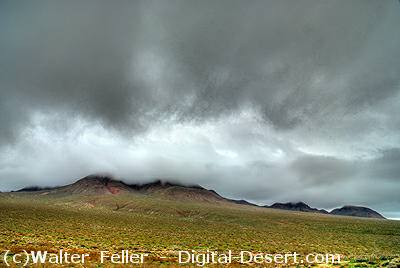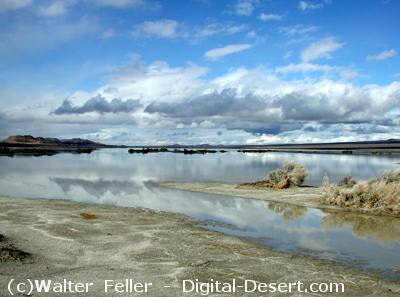Subsection 322Ag
High Desert Plains and Hills
This
subsection consists of the
western Mojave Desert,
which is mostly
alluvial plain and pediment, with relatively small areas of hills and low
mountains. It includes Indian Wells Valley north of the
Garlock Fault;
otherwise it is between the Garlock Fault on the north and northwest, the
San Andreas Fault
on the southwest, the
Mojave River
on the southeast,
and about the Harper Valley Fault on the northeast. It has a hot,
arid climate. MLRAs 29f and 30g.
Lithology
and Stratigraphy. This subsection contains mainly Mesozoic granitic
rocks and Quaternary alluvium and lacustrine deposits. Eolian sand
deposits are common. There are small areas of Precambrian gneiss
and schist and Miocene and Pliocene nonmarine sedimentary rocks.
There is a large Quaternary basalt flow in the northwestern part of Indian
Wells Valley.
Geomorphology.
This subsection is on mostly very gently to moderately sloping pediments
and alluvial fans and nearly level basin floor and dry lake bed.
There are a few moderately steep hills and steep mountains. Pediments
are quite extensive. Some of the larger dry lake beds are China Lake
in Indian Wells Valley,
Koehn Lake
in Fremont Valley, Cuddleback Lake,
Harper Lake,
Rodgers Dry Lake, Rosamond Lake, and
El Mirage Lake.
The elevation range is mostly from about 2000 to 3000 feet, but up to about
4000 feet adjacent to the Tehachapi Mountains and 4584 feet on Fremont
Peak. Fluvial erosion and deposition and eolian deflation and deposition
are the main geomorphic processes.
Soils.
The soils are mostly shallow Typic Torriorthents, Lithic Haplocambids,
Typic Haplargids, shallow Typic Haplodurids, and Typic Torripsamments on
granitic hills and pediments; Typic Torrifluvents, Typic Torripsamments,
Typic Torriorthents, Typic Haplargids, and Typic Argidurids on alluvial
fans; and Typic Torrifluvents and Typic Torripsamments on basin floor.
Soils on the rocky basalt flow in Indian Wells Valley are mainly Lithic
Torriorthents. The soils are well drained, except on poorly drained
playas. Salids occur on poorly drained playas lacking vascular plants.
Soil temperature regimes are thermic; and soil moisture regimes are aridic.
Vegetation. The predominant natural plant community
is
Creosote bush series
on hills, pediments, and fans.
Joshua tree series
is common on pediments and fans.
California juniper series
predominates above about 3000 feet near the San Andreas Fault. Mixed
saltbush series is common on basin floor and Iodine bush series and Saltgrass
series are present on wet basin-fill and lacustrine deposits. Greasewood
series occurs in riparian areas and around saltmarsh.
- Characteristic series by lifeform include:
Grasslands: Alkali sacaton series, Big galleta series, Desert needlegrass series, Desert sand verbena series, Indian ricegrass series, Saltgrass series.
Shrublands: Allscale series, Birchleaf mountain-mahogany - California buckwheat series, Brittlebrush series, California buckwheat series, Chamise series, Creosote bush series, Creosote bush - white bursage series, Desert-holly series, Fourwing saltbrush series, Greasewood series, Hop-sage series, Iodine bush series, Joshua tree series, Mixed saltbush series, Mojave yucca series, Rubber rabbitbrush series, Scalebroom series, Shadscale series, Spinescale series, White bursage series, Winter fat series.
Forests and woodlands: California juniper series, California sycamore series, Mesquite series.
Surface Water. Runoff is rapid from mountains and alluvial fans and slow from basin-fill. All drainage is internal, to closed basins in the Mojave Desert. Streams are dry most of each year. There is temporary ponding on playas, or dry lake beds. < previous - Mojave Desert - next >

clickable map - select a section to view
Saddleback Butte
Red Rock Canyon
Antelope Valley Poppy Reserve
Ripley Desert Woodland

Red Mountain

Ponding after a rain at El Mirage Dry Lake
